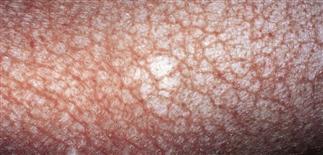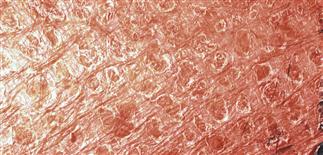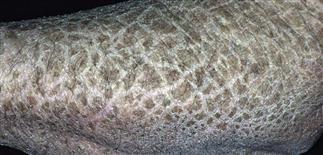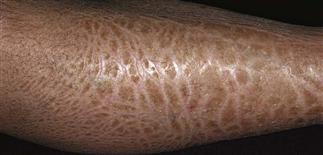21
Autosomal dominant
ichthyosis vulgaris

Ichthyosis vulgaris can have a cracked pavement appearance, and can be inflamed, especially in winter.

The scales are stuck on and will slough off and renew again. Emollients with lactic acid can help alleviate the dry appearance of ichthyosis vulgaris.

Large, dark, platelike scales characterized this ichthyosis, which is X-linked ichthyosis. Ichthyosis vulgaris can look like this, although usually the scales are not as dark.

Dried scaling skin of ichthyosis. X-linked ichthyosis vulgaris is more evident in winter. The thick scale may disappear in the summer.
DESCRIPTION
A disorder of keratinization characterized by dry, rectangular scales resembling a cracked pavement; these scales appear most prominently on the extensor extremities. Associated with the atopic diathesis in 50% of cases.
HISTORY
• Onset in early to middle childhood. • Condition may improve with age or may persist throughout life. • Scales more noticeable and often pruritic in the winter, when humidity is low. • Autosomal dominant; 1 in 300 have the disorder. • May be confused clinically with X-linked ichthyosis. • Differential diagnosis: dry skin, acquired ichthyosis as a manifestation of HIV, malignancy, drugs, autoimmune disorders, X-linked ichthyosis.
PHYSICAL FINDINGS
• Findings often mild. • Dry, small, rectangular scales appear on the extensor extremities. Lower extremities, particularly the anterior shins, often more noticeably affected. • Affected skin has the appearance of cracked pavement or fish scales. • Characteristically spares the flexor surfaces. • Usually asymptomatic but may become pruritic or chapped in winter. • Palmar creases may be accentuated. • Keratosis pilaris may also be present. • Scaling rarely involves entire cutaneous surface. • Scaling of the skin results from the retention of scale rather than increased proliferation. • No tests are routinely indicated, unless there is a question of X-linked ichthyosis. • Skin biopsy is rarely performed; when performed, it shows in a subset of patients a decreased or an absent granular layer.
TREATMENT
• Often improves with age; infrequently, it resolves completely. • Increased environmental humidity and warmth often result in resolution or improvement. • Regular application of moisturizing cream or lotion decreases pruritus and improves skin appearance. • Optimal time for applying moisturizer is immediately after bathing and hydrating the skin. • Emollients containing lactic acid, urea, or alphahydroxy acids help treat severe dryness and scaling. • Ammonium lactate 12% (Lac-Hydrin, Amlactin) lotion or cream very effective when applied daily.







